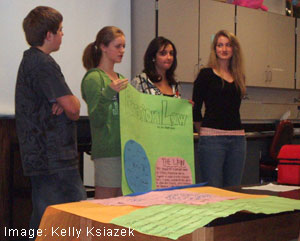Students apply what they have learned about seagrass decline and restoration as they determine how a new law should be worded in their roles as stakeholders, defending their given positions in a mock town meeting.
Objective
Students will practice making informed decisions, defend their positions using scientific evidence, and summarize what they have learned about seagrass ecology.
Materials
- Town Meeting Announcement Flier with rules (download from Lesson Resources section)
- Stakeholder Role Cards; download from Lesson Resources Section (1 per student; may be repeated)
- Timer or watch with a second hand
- Cards with “1 minute” “30sec” and “time’s up”
- Markers/chalk for the board
- Extra colored paper and/or poster paper for students to make props
- Optional: video camera, podium, microphone
Procedure
- A couple days before the discussion, post the flier announcing the town meeting so the students may start to anticipate it.
- The day before the meeting, discuss the rules and assign students to their roles and groups. A new law will be passed to help improve the quality of seagrass beds in the community (or underwater grasses if there is no seagrass in your area). What the law will say is up to the community. It can include ideas for planting grass in new areas, cleaning up current locations, etc. but tell students that the “goal” is for the law to pass with a unanimous vote. Allow the groups time to read their cards, come to a group consensus, write up a script for their presentation, create any necessary visuals or props, and practice for timing. Each group will have 4-6 minutes for their presentation and 1 minute of rebuttal time. Encourage students to bring in props or costumes on the day of the meeting to help create a group identity. The various roles are grouped into 6 Interest Groups. If you have shorter class periods and don’t have time for all 6 groups to give a 4-6 minute presentation and a 1 minute rebuttal in addition to the set-up and summary, feel free to eliminate 1 or 2 of the groups.
- On the day of the town meeting, set up the room to look like a council meeting space: use a microphone and podium for the speaker if possible. Videotaping the meeting will enhance the reality as well.
- As each group presents, have a student “scribe” summarize the major points on the blackboard to use later when trying to reach a class consensus.
- Use cue cards with “1 minute” “30 sec” and “time’s up” at the appropriate times while the groups are presenting to help them gauge timing.
- After all the groups have presented and answered questions, look over all the posted class notes. In their small groups, try to have the students write out how the underwater grass restoration law should be written. As a class, try to come up with a final plan through a discussion of each group’s ideas. The actual writing of a final plan is not as important as having the students practice informed decision making, so if a consensus is not reached, it’s OK.
National Science Education Standards
9-12 C. Life Science
- Interdependence of organisms
9-12 E. Science and Technology
- Understandings about science and technology
9-12 F. Science in Personal and Social Perspectives
- Personal and community health
- Population growth
- Natural resources
- Environmental quality
- Natural and human induced hazards
- Science and technology in local, national, and global challenges
- Science as a human endeavor
